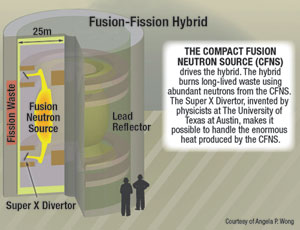In a twist on the proverb “Set a thief to catch a thief,” physicists at the University of Texas at Austin have designed a system to facilitate the disposal of spent nuclear fuel that combines nuclear fission with fusion. The hybrid system will destroy 99% of the spent fuel, and the waste that remains will be less toxic than the spent fuel now accumulating in storage at nuclear powerplants around the country, the researchers say.
President Barack Obama’s decision to halt further development of the Yucca Mountain nuclear-waste repository in Nevada and “devise a new strategy toward nuclear-waste disposal” has pushed the issue back into the “urgent” pile. Contracts signed with nuclear utilities under the Nuclear Waste Policy Act of 1982 required the Dept. of Energy to begin receiving spent fuel for permanent storage in 1998. Since the deadline passed, the utilities have successfully sued DOE for failure to perform and have won damages to compensate them for the cost of storing the waste at their plant sites. Yucca Mountain is not expected to be ready until 2017.
But in a peer-reviewed article in the January 2009 issue of “Fusion Engineering and Design,” research scientists Michael Kotschenreuther, Prashant Valanju, Swadesh Mahajan and Eric Schneider described their hybrid fusion-fission reactor for destruction of nuclear waste. First, a standard light-water reactor (LWR) will burn transuranic waste formed as fuel rods, destroying 75% of the original reactor waste. “The proliferation hazard of the waste is almost entirely eliminated” in this step, says Kotschenreuther.
The remainder, a highly radiotoxic, transuranic, long-lived waste called sludge, will be destroyed in the hybrid with the help of the fusion reaction. That reaction will destroy the vast majority of the biohazardous waste, says Kotschenreuther. “Our hybrid destroys material with a half-life of over 100,000 years.” The 1% that remains thus will be of less volume, lower biohazard and shorter half-life than what now is envisioned for Yucca Mountain, the physicists say.
The “centerpiece” of the system is a high-power Compact Fusion Neutron Source (CFNS), whose fusion reaction bombards a surrounding fission blanket with neutrons, generating 1,200 MW of power. The neutrons from the CFNS impart efficiency and stability to the waste-incineration process.
The fission reaction is widely used commercially. Fusion’s principles also are known, but it is not yet used for power generation. Research is being done at numerous locations around the world to develop a commercial fusion powerplant, with the most prominent being the $12-billion ITER project now under construction in France. But commercial power generation from pure fusion is decades away.
“The hybrid is a definite net energy producer, not a consumer, mainly because burning the fission transuranic waste creates enormous energy,” says Kotschenreuther. The hybrid’s fusion occurs in an electrically heated plasma. “The CFNS produces about 100 MW of pure fusion power and requires a bit more than 100 MW of electricity, but the fission waste burned by the CFNS produces about 1,200 MW of electricity,” Kotschenreuther says. About 200 to 300 MW of that must be used to maintain the fusion, but the rest can be sold into the grid.
ITER and the hybrid both are tokamaks, which are machines with a magnetic bottle that can contain the plasma’s temperature of more than 100 million° C for sufficiently long times. But ITER’s large size means its power density is low, while the hybrid’s smaller reactor results in a higher power density. “Handling the heat was the key problem” for the CFNS, says Valanju. “The intense heat generated in a nuclear fusion device can literally destroy the walls of the machine,” he says.
The Texas team’s response was to devise a magnetic field configuration called the Super X Divertor, which can handle the enormous heat and particle fluxes peculiar to compact devices. Mahajan describes SXD as “a magnetic restructuring of the outer edge of the magnetic bottle to increase its heat capacity by a factor of five.” By increasing the heat protection, the SXD makes the CFNS feasible, say the researchers.
The hybrid reactor has been proven in concept using the same engineering codes used to qualify and design LWR cores, but it still has far to go. Extended simulations will prepare the way for an engineering project and subsequent construction of a prototype. The researchers say one hybrid reactor will be able to destroy the waste produced by 10 to 15 LWRs. Without it, “you will need 50 to 100 Yucca Mountains in the next century,” says Valanju.





Post a comment to this article
Report Abusive Comment